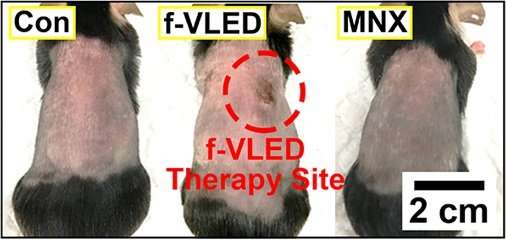A wearable device for regrowing hair

Although some people embrace the saying "bald is beautiful," for others, alopecia, or excessive hair loss, can cause stress and anxiety. Some studies have shown that stimulating the skin with lasers can help regrow hair, but the equipment is often large, consumes lots of energy and is difficult to use in daily life. Now, researchers have developed a flexible, wearable photostimulator that speeds up hair growth in mice. They report their results in ACS Nano.
Affecting millions of men and women worldwide, alopecia has several known causes, including heredity, stress, aging and elevated male hormones. Common treatments include medications, such as minoxidil, corticosteroid injections and hair transplant surgery. In addition, irradiating the bald area with a red laser can stimulate hair follicles, causing cells to proliferate. However, this treatment is often impractical for home use. So, Keon Jae Lee and colleagues wanted to develop a flexible, durable photostimulator that could be worn on human skin.
The team fabricated an ultrathin array of flexible vertical micro-light-emitting diodes (μLEDs). The array consisted of 900 red μLEDs on a chip slightly smaller than a postage stamp and only 20 μm thick. The device used almost 1,000 times less power per unit area than a conventional phototherapeutic laser, and it did not heat up enough to cause thermal damage to human skin. The array was sturdy and flexible, enduring up to 10,000 cycles of bending and unbending. The researchers tested the device's ability to regrow hair on mice with shaved backs. Compared with untreated mice or those receiving minoxidil injections, the mice treated with the μLED patch for 15 minutes a day for 20 days showed significantly faster hair growth, a wider regrowth area and longer hairs.
More information: Han Eol Lee et al. Trichogenic Photostimulation Using Monolithic Flexible Vertical AlGaInP Light-Emitting Diodes, ACS Nano (2018). DOI: 10.1021/acsnano.8b05568
Abstract
Alopecia is considered an aesthetic, psychological, and social issue among modern people. Although laser-induced skin stimulation is utilized for depilation treatment, such treatment has significant drawbacks of high energy consumption, huge equipment size, and limited usage in daily life. Here, we present a wearable photostimulator for hair-growth applications using high-performance flexible red vertical light-emitting diodes (f-VLEDs). Flexible microscale LEDs were effectively fabricated by a simple monolithic fabrication process, resulting in high light output (∼30 mW mm–2), low forward voltage (∼2.8 V), and excellent flexibility for wearable biostimulation. Finally, trichogenic stimulation of a hairless mouse was achieved using high-performance red f-VLEDs with high thermal stability, device uniformity, and mechanical durability.
Journal information: ACS Nano
Provided by American Chemical Society




















